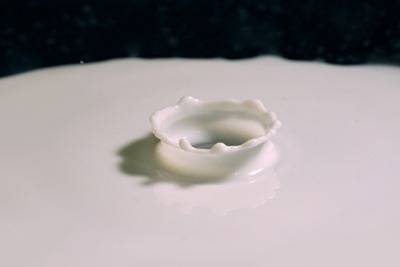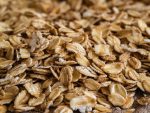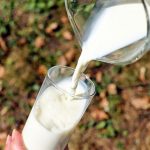
♦ The Gerber and the Babcock methods are still the standard methods for measuring fat content in milk.
Measuring the fat content of milk is important as a quality indicator and was one of the first cheap techniques in the dairy industry (Herreid, 2008), used extensively in the USA. In the late 19th century, some farmers had been rather unscrupulous. They were diluting their milk with water or taking the cream off because milk at that time was sold by volume and so pocketing more for a less valuable product.
The Babcock Method
Stephen Babcock at the University of Wisconsin developed a non-solvent wet extraction method. he found that by adding concentrated sulphuric acid (92% or 1.82 specific gravity) to 18 grams of milk, the fat would separate out. Concentrated sulphuric acid hydrolyses protein leaving the fat. Centrifuging this acidified sample at 50°C improved the separation as the fat was deaerated, it floated and its volume could be measured. A specific Babcock graduated test tube was designed for the method and the amount of fat quoted as %w/w milk. The whole test is about 45 minutes. One of its limitations is that phospholipids are not determined and it is not suitable for products containing chocolate or added sugar because of the extreme damage done to these compounds by high acid concentration.
The value of the method led to better assessment of milk quality for both consumer and producer. It also helped in the selective breeding of cows producing milk with a higher butterfat content with the tests performed by members of the Dairy Herd Improvement Association (DHIA). The method was also adopted by the American Dairy Science Association in 1922 as one of the ‘Official Methods of testing Milk and Cream for Butterfat’. With this method, specific glassware was designed to standard specifications. The method is now AOAC Method 989.04 and 989.10 (also see Nielsen, 2010).
The Gerber Method
The Gerber method is a rival but similar method and technique to the Babcock version and is primarily used in Europe and to some extent in the USA. This method is older being developed and patented by Dr. Niklaus Gerber of Switzerland in 1891. Milk fat is separated from milk proteins by adding sulphuric acid to hydrolyse the latter as in the Babcock method. The separation is facilitated by adding amyl alcohol with centrifugation to separate the fractions. The fat content is read directly using a specially calibrated butyrometer that was originally designed by Gerber. Water baths built specifically for the Gerber tubes are often employed for the analysis.
The test is the basis for numerous national and international standards employed in ISO 2446 (ISO, 1976), International Dairy Federation (FIL) Regulation 105 (IDF, 1991), BS 696 (United Kingdom), and IS 1223 (India). It is also a more widely regarded test to Babcock’s.
Other methods exist – the ether extraction method of Mojonnier which is also approved and claimed to give more consistent measures and values for fat content which are 0.021%w/w lower (Barbano et al., 1988) than that for Babcock. Larger facilities may prefer to use faster analysis techniques such as infrared spectroscopy as these greatly reduce the potential for user error and reduce the time and COSHH requirements.
References
Barbano, D.M., Clark, J.L., Dunham, C.E. (1988) Comparison of Babcock and ether extraction methods for determination of fat content of milk: collaborative study. JAOAC. 71(5) pp. 898-914
FIL-IDF (1981): Determination of fat content Gerber butyrometers 105.
Herreid, E.O. (2008) The Babcock Test; A Review Of The Literature. J. Dairy Sci. 25(4) pp. 342-343
International Dairy Federation (1991) International Provisional IDF Standard 152, “Milk and Milk Products. Determination of Fat Content. General Guidance on the Use of Butyrometric Methods,” Brussels, Belgium.
International Organization for Standardization (1976) ISO International Standard 2446, “Milk—Determination of Fat Content (Routine Method),” ISO, Geneva, Switzerland.
Nielsen, S.S. (2010) Fat Analysis Chapt. 8 In: Food Analysis (Publ. Springer) pp. 129-130


I used this article in my dissertation – hope you don’t mind but I think your little articles are great for essay and exams. I hope you write some more which would be useful for those of us taking our mid-term papers. Keep going. When I’ve qualified I’ll write for you.